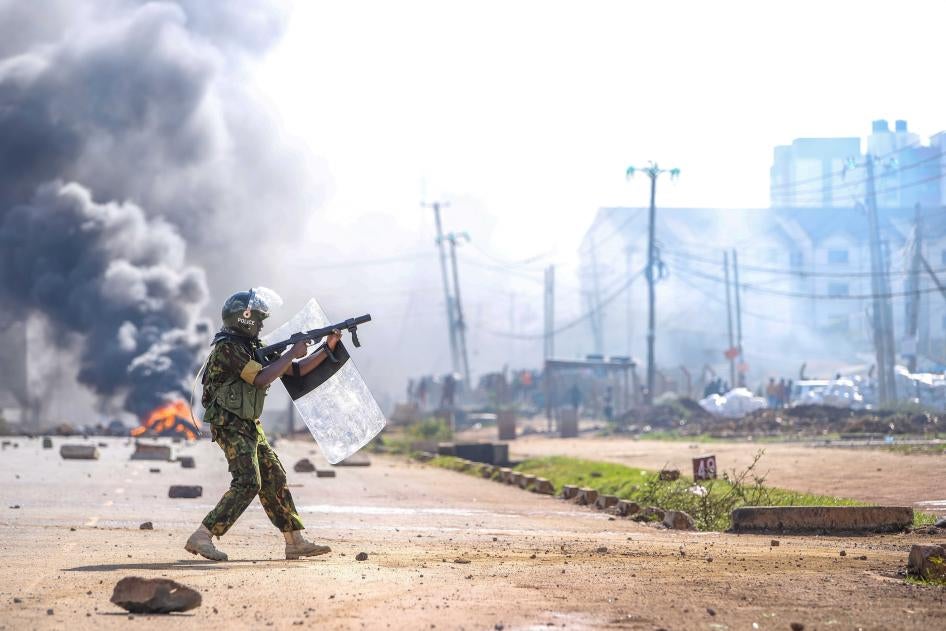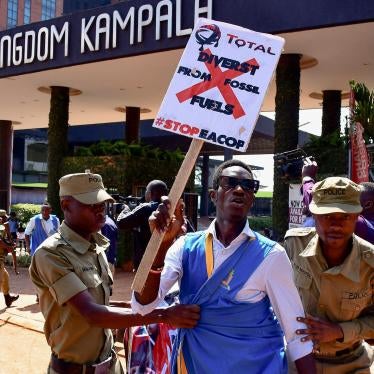(Nairobi) – Nearly two months since a series of nationwide protests began, Kenyan authorities have failed to take sufficient action to hold police officers and their commanders to account for killings and attacks on protesters and other people, Human Rights Watch and Amnesty International Kenya said today.
The Independent Policing Oversight Authority (IPOA) should urgently conclude their investigations into all deaths and the apparent unjustified use of force by the police, and all relevant authorities including the national police service, should publicly guarantee the right of everyone to peaceful assembly and protest in future, both organizations said.
In August 2022, Kenya held a disputed election, which resulted in the formation of a new government by President William Ruto. On March 9, 2023, Raila Odinga, leader of the opposing Azimio coalition, made a speech calling on Ruto’s government to address the high cost of living and alleged fraud in the 2022 elections, among other issues. The first protests began on March 20, 2023, with Odinga announcing further biweekly demonstrations.
In mid-April, bipartisan talks between the government and the opposition stalled and protests re-started on May 2. The next day, Odinga announced a suspension of the demonstrations to allow engagement with Ruto’s government, promising further demonstrations should the talks fail.
“Kenyan authorities should stop glossing over the abuse of protesters by the police and other acts of violence,” said Mausi Segun, Africa director at Human Rights Watch. “They should urgently and thoroughly investigate police abuse during recent protests, including the failure to protect demonstrators from attacks by others.”
Between April 7 and 17, Human Rights Watch and Amnesty International Kenya interviewed 115 witnesses and victims of police violence during protests in Nairobi and the towns of Kisumu, Migori, and Homa Bay. The organizations found that the authorities deployed riot police who repeatedly attacked people or otherwise used excessive and unnecessary force, including lethal force, to suppress the protests on March 20, 27, and 30. The groups documented killings, illegal arrests, beatings, destruction of civilian property, indiscriminate and disproportionate use of tear gas and water cannons, and other serious rights violations.
News media, the national human rights commission, and civil society documented various rights violations by the authorities during the March protests. They also condemned the declaration by President Ruto, the government, and police officials that the protests were illegal during the March upheavals.
Human Rights Watch and Amnesty International Kenya corroborated 12 killings in interviews with family members and witnesses. While some of the victims were involved in the protest, most of the 12, according to the witnesses interviewed, were bystanders, passersby, or people in their homes and business premises. In a few instances in Kisumu and Nairobi, multiple sources said that police fired live bullets in residential areas and inside classrooms in schools and colleges.
In one case, relatives of Elijah Okumu, 26, said the police shot him during the protests on March 27 as he was closing his shop in Dandora neighborhood, Nairobi. Relatives rushed Okumu to Mama Lucy Hospital in eastern Nairobi and later transferred him to Kenyatta National Hospital, where he died from his injuries.
A relative said the family reported the killing to the Independent Policing Oversight Authority but that as far they have been able to determine, there has been no investigation of the killing.
Human Rights Watch and Amnesty Kenya also documented about 30 cases of gunshot injuries in Kisumu and Nairobi.
In one case, the police arrested, beat, and shot a secondary school student, Brian Carlos Oduor, in Korumba in the Riat neighborhood of Kisumu on March 30, on suspicion that he was a protester. Oduor and witnesses who spoke to Human Rights Watch and Amnesty International Kenya said that at the time of his arrest he was carrying a gas cylinder, which he told police officers he was going to refill.
The officers threw him out of their Land Cruiser vehicle and had begun kicking him when a gunshot went off, and Oduor realized he had been shot in his lower left arm. The police officers then fled, leaving Oduor injured and alone. He received first aid from passersby, who rushed him to a hospital for treatment.
Researchers also documented a brutal police crackdown on journalists from various media outlets who were covering the March 30 protests on Outering Road near the Pipeline estate in Nairobi. The journalists said the police tried to prevent them from live streaming the protest and used water cannons to destroy cameras, harassed some journalists, and forced others to delete footage. The journalists said they felt targeted, frightened, and unable to help people who were injured.
“The demonstrations were peaceful, people were chanting, people were happy, waving. But now reaching to where the police were, they [the police] threw tear gas,” one journalist said. “Vehicles and protesters on foot were blocked from either side by the police with no exit route. The air was suddenly filled with tear gas and colored water … we were trapped and gasping for air.”
Police also fired tear gas into residential neighborhoods including people’s homes and schools, which affected people’s health and led to the death of at least two children, witnesses said. Joyce Kemunto, 39, said she lost her 4-month-old daughter after police shot tear gas in Kibera, Nairobi on March 30.
“When the tear gas was thrown, some of the canisters landed on the roof and the smoke came inside where my 4-month-old baby, Precious, was,” she said. “My baby started crying. I took a cloth and water and began wiping her face alongside my other children … There was nowhere to go outside because tear gas was being thrown everywhere. So, we stayed inside, and the baby cried until she stopped breastfeeding.” She said that the baby’s condition worsened, and she started bleeding from her nose, and died on the way to a hospital.
Similarly, 31-year-old Jackline Moraa from Kibera, Nairobi lost her youngest son on April 4, following exposure to tear gas after police threw tear gas into their neighborhood on March 30. She said doctors at Mbagathi Hospital suspected that the tear gas had affected his chest, leading to breathing difficulties.
While the protests appear to have been mostly peaceful, Human Rights Watch and Amnesty International Kenya found that some individuals committed grave acts of violence during the protests, including theft, looting, and attempted rapes and caused grievous bodily harm. While the media have reported some arrests, Human Rights Watch and Amnesty International Kenya found that police failed to intervene to stop the violence or to investigate in some cases.
Ali Said, 17, said he was attacked by a group of protesters with crude weapons in Kaloleni, Kisumu on March 27. Said said the protesters beat him severely and cut his stomach with a knife. He was later rescued by a [motorcycle] rider, who rushed him to the hospital. He reported the attack to the police, but said he was not aware of any police actions or investigations into his case.
The rights to life, peaceful assembly, association, and freedom of expression are fundamental human rights, guaranteed under Kenya’s Constitution as well as international human rights treaties to which Kenya is bound, including the African Charter on Human and People’s Rights and the International Covenant on Civil and Political Rights.
The UN Principles on the Use of Force and Firearms allow the police to use force only when strictly necessary and to the extent required to achieve a legitimate objective. Forces should only use tear gas when necessary to prevent further physical harm and where possible issue an advance warning. During violent protests, use of tear gas must be proportional to the seriousness of the offense, must meet a legitimate law enforcement objective, and should be used in a way that minimizes the risk of harm. The deliberate use of lethal force is only permissible when it is strictly necessary to protect life.
Amnesty International Kenya and Human Rights Watch have independently and jointly previously documented political interference in efforts to achieve accountability for police abuses, as well as investigative failures by the oversight authority, lack of police cooperation, lack of political will to end the abuses and ensure accountability, and stalled police reforms.
Guaranteeing budgetary independence of the police service and Independent Policing Oversight Authority are key to ensuring independence of the two institutions and will go a long way toward achieving police reforms including accountability for abuse, Human Rights Watch and Amnesty International Kenya said.
“Brutal policing of protests guaranteed under our constitution is unacceptable,” said Irũngũ Houghton, executive director at Amnesty International Kenya. “Kenyan authorities need to take meaningful steps to preempt violent protests by facilitating the right to assembly and hold officers criminally accountable for unlawful policing. Failure to act on the March brutality opens the door to more violence in future.”
|
News Release
Kenya: End Abusive Policing of Protests
Accountability, Fundamental Reforms Urgently Needed
Your tax deductible gift can help stop human rights violations and save lives around the world.
Topic
Most Viewed
-
January 8, 2026
Iran: Authorities’ Renewed Cycle of Protest Bloodshed

-
November 25, 2019
A Dirty Investment

-
January 8, 2026
Myanmar: Critical Hearings in Rohingya Genocide Case

-
March 29, 2021
“Everything I Have to Do is Tied to a Man”

-
December 19, 2024
Extermination and Acts of Genocide




